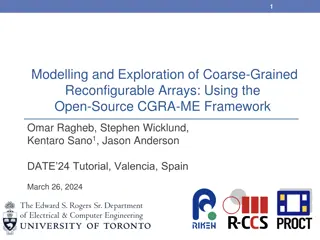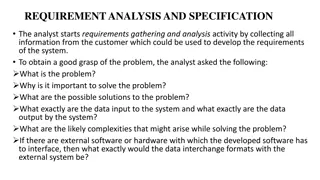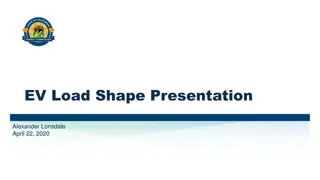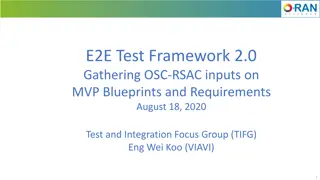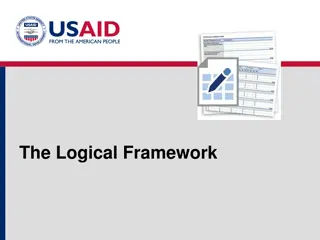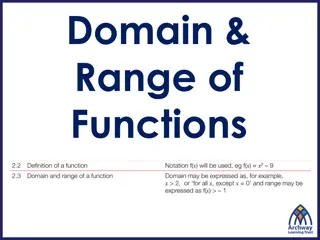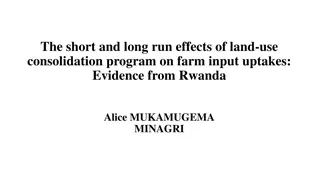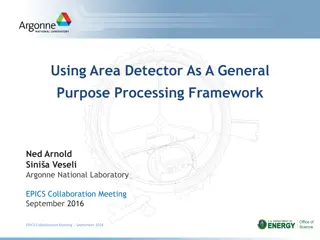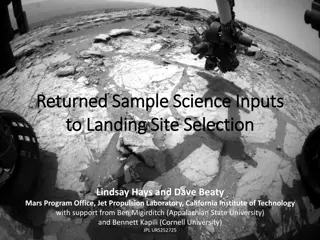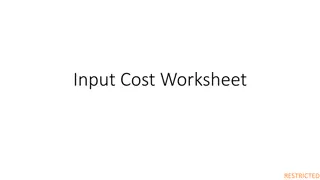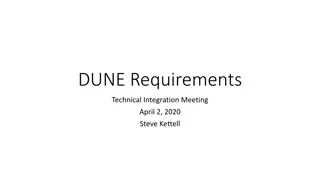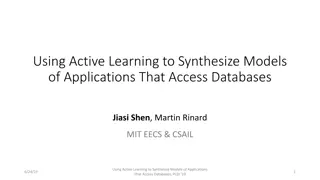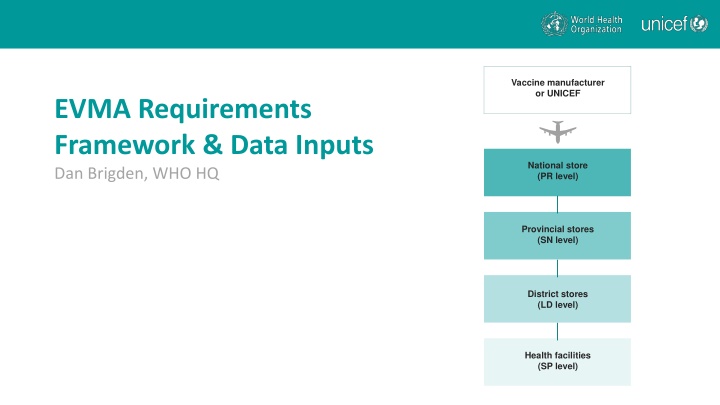
EVMA Requirements Framework & Data Inputs
In this framework, EVM assesses functions like temperature management, stock management, and waste management across various levels of health facilities. The assessment includes evaluating criteria such as facility management, annual needs forecasting, vaccine management, and more. The process involves defining minimum requirements and setting standards for inputs, outputs, and performance.
Download Presentation

Please find below an Image/Link to download the presentation.
The content on the website is provided AS IS for your information and personal use only. It may not be sold, licensed, or shared on other websites without obtaining consent from the author. If you encounter any issues during the download, it is possible that the publisher has removed the file from their server.
You are allowed to download the files provided on this website for personal or commercial use, subject to the condition that they are used lawfully. All files are the property of their respective owners.
The content on the website is provided AS IS for your information and personal use only. It may not be sold, licensed, or shared on other websites without obtaining consent from the author.
E N D
Presentation Transcript
Vaccine manufacturer or UNICEF EVMA Requirements Framework & Data Inputs Dan Brigden, WHO HQ National store (PR level) Provincial stores (SN level) District stores (LD level) Health facilities (SP level)
EVM Requirements Framework
Some background (criteria) EVM assesses functions, e.g: temperature management (E2) stock management (E6) waste management (E9) Let s call these criteria.
EVM assesses the following criteria/functions Facility management: Programme management: Facility operations: M1 Annual needs forecasting SY Immunization supply chain system E1 Vaccine arrivals ST Strategic planning E2 Temperature management M2 Annual work planning R1 Infrastructure management E3 Storage and transport capacity M3 Supportive supervision R2 Equipment management E4 Storage of vaccines and dry goods M4 iSC performance monitoring R3 IT systems management E5 Maintenance R4 Human resources management E6 Stock management R5 Knowledge management E7 Distribution of vaccines and dry goods R6 Financial resources management E8 Vaccine management E9 Waste management
Some background (categories) All functions (e.g. baking a cake, storing vaccines, making whiskey) require 6 different types of input. Inputs Staff Training SOPs Stock record form Computer Outputs Stock records are complete, accurate, well organised Requisition-issue-receipt records are complete, well organised Performance No stock-outs All requests met in full and on time Stock management
Some background (categories) EVM assesses the required inputs, and the expected outputs and performance of those functions (EVM criteria). Let s call these categories. EVM defines minimum requirements (standards) for the inputs, outputs and performance of criteria.
EVM assesses the required inputs, and the expected outputs and performance of criteria Performance: Input categories: Output: P Performance C1 Infrastructure O Output C2 Equipment C3 Information technology C4 Human resources C5 Policies & procedures C6 Financial resources EVM > Criterion > Category > Requirement > Question
EVM input categories and sub-categories C4 Human resources C1 Infrastructure C4.1 Staffing C1.1 Utilities & services C1.2 Buildings & facilities C4.2 Training C2 Equipment C4.3 Knowledge & understanding C2.1 Storage equipment C5 Policies & procedures C2.1.1 Cold storage equipment C5.1 Evidence C2.1.2 Other storage equipment C5.2 Policy & strategy C2.2 Transportation equipment C5.3 SOPs C2.2.1 Vehicles C5.4 Contracts C2.2.2 Insulated containers C6 Financial resources C2.3 Other equipment C6.1 Salaries C3 Information technology C6.2 Funds for operations C3.1 General IT equipment C6.3 Funds for development C3.2 Data management technology
Example: E5 E5 Maintenance & C5 C5 Policies / procedures
iSC location functions EVMA 2.0 Criterion scores EVMA 2.0 EVMA 2.0 iSC iSC PERFORMANCE SCORES PERFORMANCE SCORES
iSC location functions EVMA 2.0 Category scores EVMA 2.0 EVMA 2.0 iSC iSC PERFORMANCE SCORES PERFORMANCE SCORES
EVMA 2.0 EVMA 2.0 iSC iSC PERFORMANCE SCORES PERFORMANCE SCORES Five Supply Chain Essentials also
EVMA EVMA ASSESSMENT ASSESSMENT An EVM assessment requires 3 data inputs: COUNTRY SET-UP DATA MANAGEMENT DATA COLLECTION EVM Assessment Manager (website) THE ADMINISTRATION TOOL EVM Locations (mobile app) THE DATA-COLLECTION TOOL EVM Global Dashboard (website) GLOBAL DATA ANALYSIS Immunization supply chain system 1 3 Location questionnaire Program management questionnaire 2
COUNTRY SET COUNTRY SET- -UP UP 1 The country manager defines the immunization supply chain system for a particular country. Not used to assess. S1 Vaccination schedule S2 Supply chain parameters (nominal supply intervals, safety stocks, ) S3 Tracer products S4 Administrative units (state names, districts names, etc, and administrative relationships) S5 Supply chain locations (vaccine stores and health facilities, and supply chain relationships)
PROGRAM MANAGEMENT QUESTIONNAIRE PROGRAM MANAGEMENT QUESTIONNAIRE 2 The country manager and the management staff (e.g. EPI manager, iSC manager) conduct the program management questionnaire. SY Immunization supply chain system ST Strategic planning R1 Infrastructure management R2 Equipment management R3 IT systems management R4 Human resources management R5 Knowledge management R6 Financial resources management
LOCATION QUESTIONNAIRES LOCATION QUESTIONNAIRES 3 Trained field assessors, normally national staff, fill out location questionnaires to determine if the iSC facility operations and management requirements are met. The questions are designed to be as objective and simple to answer as possible (most questions are binary, some numerical). The location questionnaire structure is designed to facilitate quick collection of quality data. The location questionnaire sections correspond to physical locations or entities, and the recommended completion order follows a logical tour of the location.
LOCATION QUESTIONNAIRES LOCATION QUESTIONNAIRES 3 Sections SOPs L18 SOPs Records Administration L1 L2 Setup L3 L4 L5 HR L6 L7.1 Staff interview 1 Location tour L8 Office L9 Infrastructure L10 Generator L11 Vehicle L12 Waste management facilities L13 Building L14 Cold/freezer room L15 Refrigerator/freezer L16 Storage and transport capacity L17 Immunization facilities L18 Standard operations procedures (SOPs) L19 Vaccine arrivals L20 Temperature management L21 Maintenance L22 Stock management L23 Stock management performance L24 Vaccine distribution L25 Outreach L26 Immunization waste management L27 Vaccine needs forecasting L28 Annual work planning L29 Cold chain equipment inventory L30 Vehicle inventory L31 Supportive supervision L32 ISC performance monitoring Observation L33 Packing insulated containers L34 Loading refrigerated vehicles L35 Unloading refrigerated vehicles L36 Immunization session Assessment details Location details Vaccination schedule Supply chain parameters Tracer products Staff
A word from Paul a criterion is a functional area, a set of tasks, nothing else. by listing the tasks that fall under a criterion, as i have done in the criterion guidance, i am defining the criterion. a criterion is not "used to assess ...". a questionnaire section is "used to assess ...". EVMA 2.0 sets requirements on the inputs, outputs and performance of each functional area/criterion. an input category is one of 6 pre-defined, function-generic, input categories. all functions, from washing your hair to running a school, requires these inputs, and nothing more. consider these like the factors of production in economics (land, capital, technology, labour, knowledge; funds are not considered a factor of production in economics). by listing the inputs under a category, as i have done in the category guidance, i am defining that category. this logical structure is implemented in EVMA 2.0. EVMA 1.0 attempted to do something like this but didn't quite manage. some of the EVMA 1.0 criteria are categories, some of the categories are criteria. some are both.




